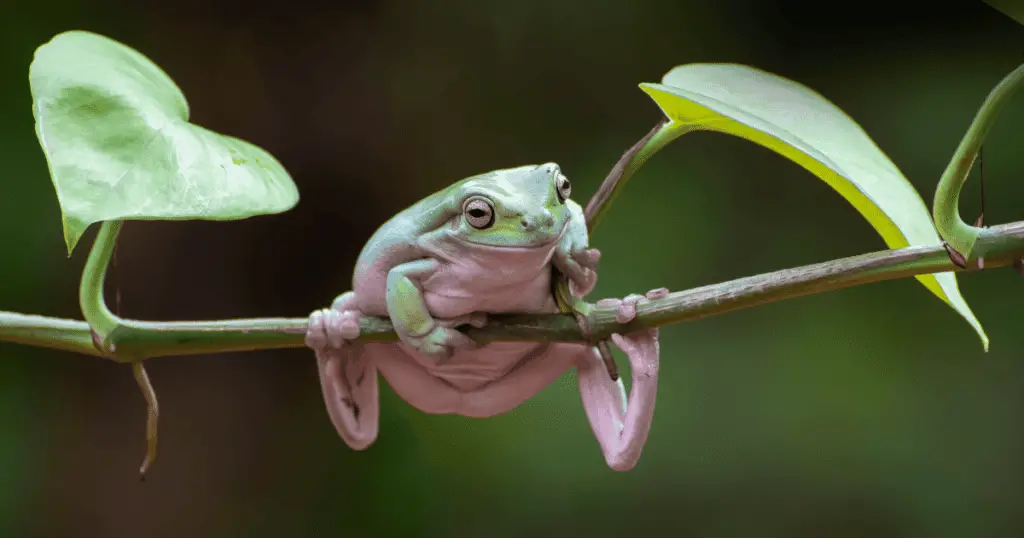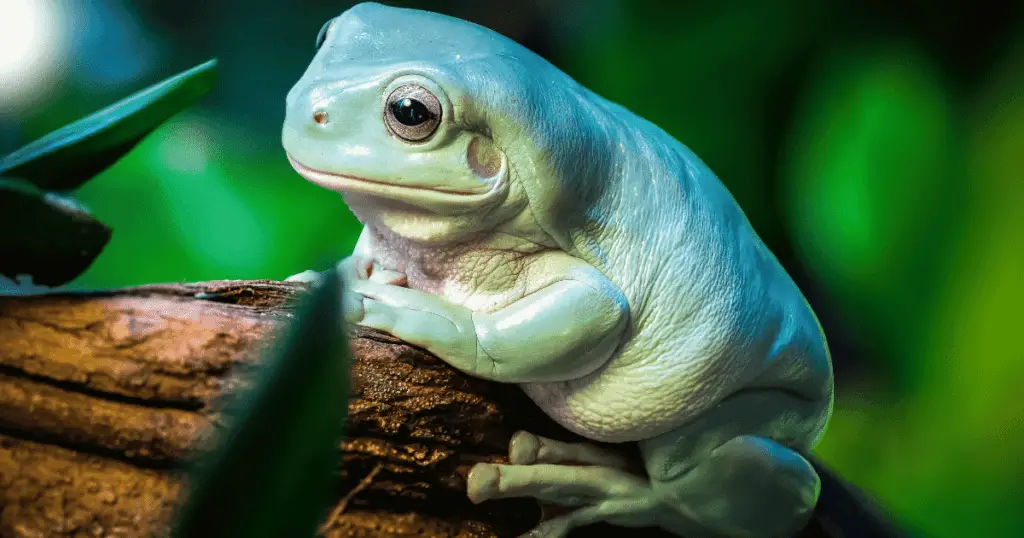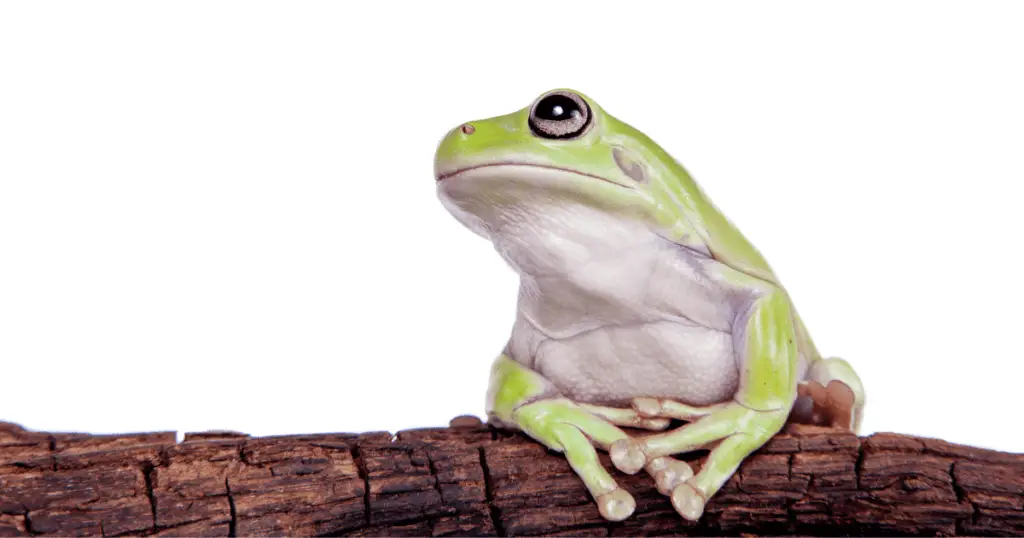Explore the charming world of the Australian White Tree Frog’s size. Learn about their size variations, whether or not they’re toxic, and how they compare to the largest frogs that have ever lived. Dive into detailed insights with our comprehensive guide.
Introduction

The Australian White Tree Frog, scientifically known as Litoria caerulea, is a captivating species native to Australia and New Guinea. Renowned for its vibrant, green color and docile nature, this amphibian has gained popularity as a pet worldwide.
This article delves into the unique size characteristics of this frog, providing insights that intrigue prospective pet owners, researchers, and amphibian enthusiasts, and enhance their understanding of the Australian White Tree Frog’s distinctiveness.
Understanding Australian White Tree Frog Size
Australian White Tree Frogs typically reach a length of 3 to 4.5 inches (7.5 to 11 cm), making them a moderately sized frog species. However, their size can vary significantly due to factors such as diet, environment, and genetics.
Understanding these size variations is crucial for providing the right care and habitat, as it directly impacts their housing and dietary needs. This knowledge empowers prospective owners, researchers, and enthusiasts to take responsible actions for the frog’s well-being.
Australian White Tree Frog Size at Different Stages of Life
From delivery, Australian White Tree Frogs demonstrate a captivating growth journey. Hatchlings are initially tiny but develop hastily inside their first few months. Juvenile frogs can double or triple in size in a concise duration, relying on the availability of meals and their environment’s satisfaction.
By knowing the increased levels of the Australian White Tree Frog, fanatics and researchers can better cater to their developmental needs, ensuring healthful growth through every phase of life.
Comparing the Australian White Tree Frog Size to Other Amphibians
Compared to other amphibians, the Australian White Tree Frog holds its very own, with a specific size that is neither too huge nor too small. For instance, it’s miles larger than many not-unusual lawn frogs but smaller than the massive amphibians, just like the Goliath Frog or maybe a few large species of toads.
Habitat and Its Impact on Australian White Tree Frog Size
The Australian White Tree Frog’s herbal habitat spans rainforests, grasslands, and areas close to human dwellings, which offer varied possibilities for safe haven and food. The adaptability of those frogs to exclusive environments is exceptional.
However, their length may be encouraged using the unique situations in their habitats. In captivity, for instance, their growth may be maximized with the surest area and dietary availability.
Diet and Nutrition: Effects on Australian White Tree Frog Size

The Australian White Tree Frog’s diet is pivotal in determining its size and overall health. In the wild, it primarily consists of insects, including moths, flies, and crickets. In captivity, it may also consume commercially prepared frog food that provides specific balanced nutrients. Proper feeding is crucial for its growth; a well-fed frog is generally healthier and grows more significantly than those in environments lacking essential nutrients.
Australian White Tree Frog: Is It Poisonous?
Contrary to what a few may count on, the Australian White Tree Frog isn’t poisonous. This is a giant for puppy owners and educators because the manner of dealing with those frogs poses no poisonous chance to human beings.
Their non-toxic nature makes them outstanding pets suitable for families with kids. However, cleaning your fingers before and after managing any amphibian is usually encouraged to save you from unfolding microorganisms such as Salmonella.
The Biggest Frog That Ever Lived: A Comparative Insight
| Frog Species | Size (Length) | Native Region | Description |
|---|---|---|---|
| Australian White Tree Frog | 3 to 4.5 inches | Australia, New Guinea | Known for its docile nature and vibrant green color. |
| Giant Monkey Frog | 4 to 5 inches | Amazon Rainforest | One of the largest tree frogs, noted for its size and unique call. |
| Beelzebufo ampinga (Devil Frog) | Up to 16 inches (prehistoric) | Madagascar | Extinct species known as the largest frog that ever lived. |
Breeding and Its Impact on Australian White Tree Frog Size
Breeding behaviors in Australian White Tree Frogs can also impact their size. During the breeding season, male frogs often show mild growth in length due to swelling of the vocal sacs, which they use to attract women.
The offspring’s size may be motivated by the fitness and size of the dad and mom, specifically the mother. Understanding those breeding-caused size versions allows breeders and hobbyists to control and expect adjustments of their frogs at some point of reproductive intervals.
Health Concerns Related to Australian White Tree Frog Size
- Obesity Risks: Like other pets, Australian White Tree Frogs can become overweight if overfed, particularly in environments where they are less active. Obesity can cause health problems, including joint strain and increased susceptibility to diseases such as fungal infections and respiratory issues. Developmental Disorders: Insufficient or inadequate nutrient intake throughout key increase levels can lead to developmental disorders affecting length, bone fitness, and ordinary energy.
- Stress and Vulnerability: Smaller or more significant than common frogs might also experience higher stress levels, affecting their immune systems and making them more susceptible to infections and illnesses.
- Impact of Size on Reproductive Health: Improper body size can affect breeding abilities. Overweight females may struggle during oviposition (the process of laying eggs), while underweight individuals may not reproduce efficiently. Enclosure-Related Issues: If the frog’s size isn’t compatible with its environment—for instance, an enclosure that is too small—it can result in stress and physical discomfort, which may contribute to fitness headaches.
Conservation Status and Size Implications for Australian White Tree Frogs

The conservation status of Australian White Tree Frogs is currently listed as ‘Least Concern’ by the IUCN Red List. However, ongoing threats such as habitat loss and climate change require our attention. Smaller populations, especially those isolated by environmental changes, may exhibit reduced genetic diversity, which can impact their size and vitality.
This underscores the importance of conservation efforts in maintaining healthy populations in both wild and captive environments, a cause that should motivate all of us.
Caring for an Australian White Tree Frog: Size Considerations
Proper care of an Australian White Tree Frog includes several important factors, with size being a significant consideration. The size of the enclosure should be sufficient to allow for comfortable movement and exercise, typically a tank of at least 10 gallons for a single frog. Additionally, the habitat’s interior should include adequate climbing and hiding areas, as these frogs are both arboreal (tree-dwelling) and nocturnal.
Final Thoughts
In conclusion, the size of the Australian White Tree Frog varies depending on several elements, including genetics, weight loss plan, and environmental situations. Understanding and accommodating those length-associated needs is critical for every person seeking to care for these frogs, whether as pets or in a conservation context. By promoting awareness and training on the proper care and management of these amphibians, we are able to ensure their fitness and toughness.
Frequently Asked Questions
Australian White Tree Frogs, usually called Dumpy Tree Frogs due to their stocky build and ‘dumpy’ appearance, typically attain a duration of 3 to 4—to five inches (7.5 to 11 to 5 cm). Males usually are smaller than girls. However, the size can vary depending on factors, which include food regimen, fitness, and living conditions.
The title of the world’s largest tree frog is held by the Giant Monkey Frog (Phyllomedusa bicolor), which is local to the Amazon Rainforest. This species can grow as much as four to five inches (10 to 12.5 cm) in a period, making it slightly larger than the Australian White Tree Frog.
Dumpy” is a nickname regularly given to the Australian White Tree Frog, especially the ones of considerable length within the species. Adult Dumpy Tree Frogs can vary from 3 to 4 inches (7. Five to eleven. Five 11in period. However, specific people nicknamed “Dumpy” may additionally vary within this range, depending on the equal factors that affect their trendy length.
Dumpy Tree Frogs tend to be ‘big’ because of their sturdy, stocky construct, which is a function of the species. Their size can also be stimulated by ample food supply and premier living conditions in captivity. Adequate nutrients throughout their developmental segment can result in healthier, regular giant frogs. Additionally, genetic elements can play a significant role in the ordinary size of these individuals.

Hello! I’m Javed, a versatile content writer specialized in various niches, with a particular passion for home and garden topics. My expertise extends beyond writing—I’m also skilled in SEO and WordPress development, boasting over four years of experience in these areas.
